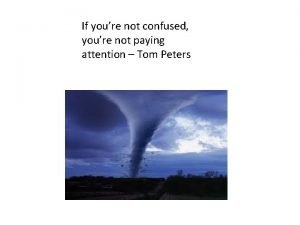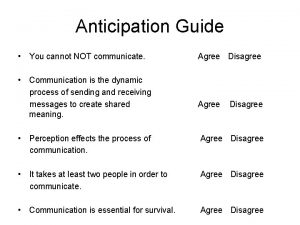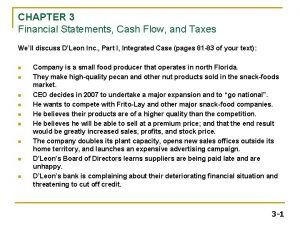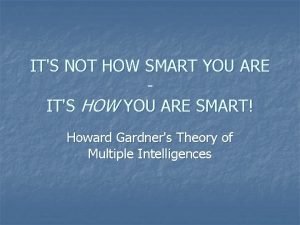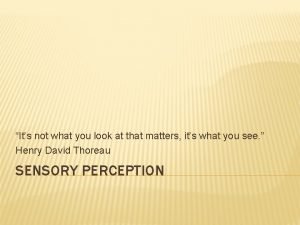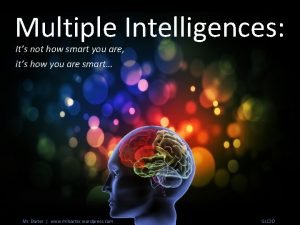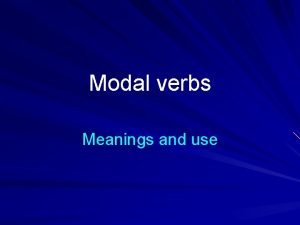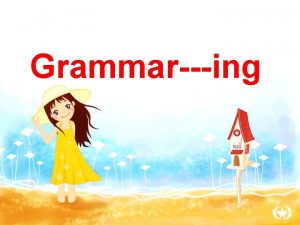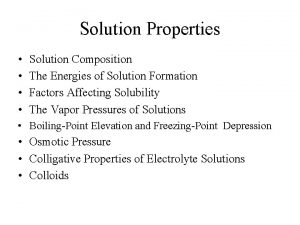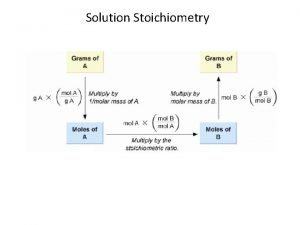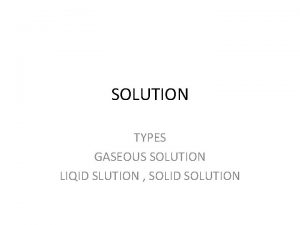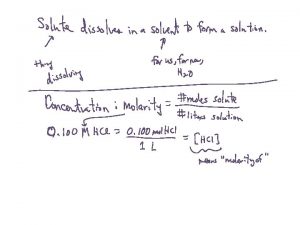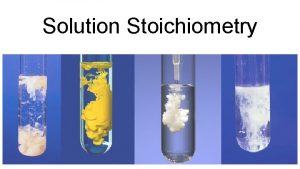If you are not part of the SOLUTION






















- Slides: 22

If you are not part of the SOLUTION, you’re part of the PRECIPITATE! SOLUTION S

THREE TYPES OF MIXTURES SOLUTIONS COLLOIDS SUSPENSIONS The particle size determines the type of mixture. Solutions and Colloids are homogeneous; suspensions are heterogeneous.

MIXTURES

MIXTURES TYNDALL EFFECT: particles dispersed in mixture are big enough to scatter light.

SOLUTIONS A solution is a mixture that has the same composition, color, and density throughout. It is homogeneous. Solutions form when particles of solute are interspersed evenly throughout the solvent.

SOLUTIONS It has two parts: SOLUTE: the substance being dissolved; in smaller abundant. SOLVENT: the substance doing the dissolving; the greater amount.

SOLUTIONS Solutions can be one of nine basic types: Liquid Solutions: solid in liquid (salt water) liquid in liquid (vinegar) gas in liquid (carbonated drink) Gaseous Solutions (All gaseous mixtures are solutions): solid in gas (soot in air) liquid in gas (humid air) gas in gas (air)

SOLUTIONS Solid Solutions - usually made from liquid solutions that have been mixed and then solidified (frozen): solid in solid (alloys – brass, bronze) liquid in solid (dental fillings) gas in solid (charcoal gas mask)

THE DISSOLVING PROCESS Dissolving occurs when the solute is pulled apart by the solvent. This takes place at the surface of the solute. The solvent surrounds the solute. When ionic compounds separate into their ions in a solvent, dissociation occurs.

THE DISSOLVING PROCESS Remember that opposites attract. So when a positive ion comes near a negative ion, there is an attraction. Polar molecules have a negative end a positive end. Polar molecules are attracted to each other.

DISSOCIATION OF Na. Cl

THE DISSOLVING PROCESS Electrolytes are compounds that break apart in water forming ions that conduct electricity. Ions are polar. Ionization is when electrolytes dissolve in water and separate into ions. So a solution with ions conducts electricity.

THE DISSOLVING PROCESS Nonpolar molecules are not attracted to each other or to polar molecules. Nonelectrolytes are substance that do not ionize in water and cannot conduct electricity. They may still dissolve in water. A solution with nonelectrolytes does not conduct electricity.

Solute-Solvent Combinations to solute and solvent are based on properties of each. There are FOUR main types.

Solute-Solvent Combinations 1. Polar Solvent – Polar Solute: The polar solvent is attracted to the polar solute. The solvent gradually surrounds the solute. The particles attach themselves due to polar attraction. Dissolving occurs. Like dissolves like. Example: Salt in water

Solute-Solvent Combinations 2. Polar Solvent – Nonpolar Solute: Polar solvent particles are attracted to each other and not the solute. Dissolving does not occur and a solution is unlikely. Example: oil in water.

Solute-Solvent Combinations 3. Nonpolar Solvent – Polar Solute: Nonpolar solvent particles have little attraction to the polar solute. Solvation does not occur and a solution is unlikely. Example: Salt in oil.

Solute-Solvent Combinations 4. Nonpolar solvent – nonpolar solute: Random motion of solute particles causes them to leave the surface of the solute and become evenly dispersed in the nonpolar solvent. Solvation occurs. Like dissolves like. Example: Styrofoam® in acetone.

REAL-WORLD SOLUTIONS Alcohol has a polar end a nonpolar end so it will work with polar and nonpolar solvents

REAL-WORLD SOLUTIONS Soap is another molecule with a nonpolar end a polar end that is good at lifting oils and other nonpolar solutes in water which is polar.

REAL-WORLD SOLUTIONS Many nonpolar solvents are flammable or toxic. Dry cleaners use nonpolar solvents. Turpentine is a nonpolar solvent that can dissolve oil-based paints.

REAL-WORLD SOLUTIONS Vitamins – some vitamins are polar (B vitamins and Vitamin C) so they dissolve in water and other are nonpolar (Vitamins A, D, E, and K). You have to make sure you do not overdose on the nonpolar ones because they are not easily eliminated by the body.
 Mikael ferm
Mikael ferm If you're not confused you're not paying attention
If you're not confused you're not paying attention If you can't measure it it doesn't exist quote
If you can't measure it it doesn't exist quote Uncontrolled, lacking in restraint
Uncontrolled, lacking in restraint You can not not communicate
You can not not communicate Vapour pressure composition curve for non ideal solution
Vapour pressure composition curve for non ideal solution D'leon inc part 1 solution
D'leon inc part 1 solution Death could not hold you the veil tore before you meaning
Death could not hold you the veil tore before you meaning It’s not just what you say, it’s how you say it.
It’s not just what you say, it’s how you say it. Interserf
Interserf Smart is something you become not something you are
Smart is something you become not something you are It's not what you look at that matters, it's what you see.
It's not what you look at that matters, it's what you see. If you finish your homework before school
If you finish your homework before school It's not how smart you are
It's not how smart you are I can hear you quite well. you not shout
I can hear you quite well. you not shout If you would not be forgotten as soon as you are dead
If you would not be forgotten as soon as you are dead I have not rejected you
I have not rejected you Hát kết hợp bộ gõ cơ thể
Hát kết hợp bộ gõ cơ thể Frameset trong html5
Frameset trong html5 Bổ thể
Bổ thể Tỉ lệ cơ thể trẻ em
Tỉ lệ cơ thể trẻ em Voi kéo gỗ như thế nào
Voi kéo gỗ như thế nào Chụp tư thế worms-breton
Chụp tư thế worms-breton

